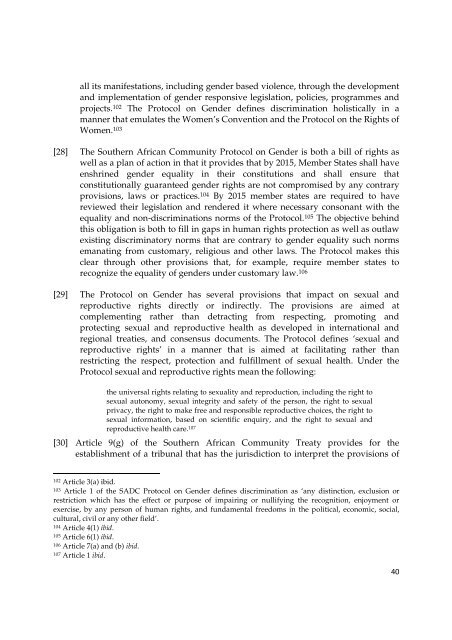sexual health and human rights in the african region - The ICHRP
sexual health and human rights in the african region - The ICHRP
sexual health and human rights in the african region - The ICHRP
Create successful ePaper yourself
Turn your PDF publications into a flip-book with our unique Google optimized e-Paper software.
all its manifestations, <strong>in</strong>clud<strong>in</strong>g gender based violence, through <strong>the</strong> development<br />
<strong>and</strong> implementation of gender responsive legislation, policies, programmes <strong>and</strong><br />
projects. 102 <strong>The</strong> Protocol on Gender def<strong>in</strong>es discrim<strong>in</strong>ation holistically <strong>in</strong> a<br />
manner that emulates <strong>the</strong> Women’s Convention <strong>and</strong> <strong>the</strong> Protocol on <strong>the</strong> Rights of<br />
Women. 103<br />
[28] <strong>The</strong> Sou<strong>the</strong>rn African Community Protocol on Gender is both a bill of <strong>rights</strong> as<br />
well as a plan of action <strong>in</strong> that it provides that by 2015, Member States shall have<br />
enshr<strong>in</strong>ed gender equality <strong>in</strong> <strong>the</strong>ir constitutions <strong>and</strong> shall ensure that<br />
constitutionally guaranteed gender <strong>rights</strong> are not compromised by any contrary<br />
provisions, laws or practices. 104 By 2015 member states are required to have<br />
reviewed <strong>the</strong>ir legislation <strong>and</strong> rendered it where necessary consonant with <strong>the</strong><br />
equality <strong>and</strong> non-discrim<strong>in</strong>ations norms of <strong>the</strong> Protocol. 105 <strong>The</strong> objective beh<strong>in</strong>d<br />
this obligation is both to fill <strong>in</strong> gaps <strong>in</strong> <strong>human</strong> <strong>rights</strong> protection as well as outlaw<br />
exist<strong>in</strong>g discrim<strong>in</strong>atory norms that are contrary to gender equality such norms<br />
emanat<strong>in</strong>g from customary, religious <strong>and</strong> o<strong>the</strong>r laws. <strong>The</strong> Protocol makes this<br />
clear through o<strong>the</strong>r provisions that, for example, require member states to<br />
recognize <strong>the</strong> equality of genders under customary law. 106<br />
[29] <strong>The</strong> Protocol on Gender has several provisions that impact on <strong>sexual</strong> <strong>and</strong><br />
reproductive <strong>rights</strong> directly or <strong>in</strong>directly. <strong>The</strong> provisions are aimed at<br />
complement<strong>in</strong>g ra<strong>the</strong>r than detract<strong>in</strong>g from respect<strong>in</strong>g, promot<strong>in</strong>g <strong>and</strong><br />
protect<strong>in</strong>g <strong>sexual</strong> <strong>and</strong> reproductive <strong>health</strong> as developed <strong>in</strong> <strong>in</strong>ternational <strong>and</strong><br />
<strong>region</strong>al treaties, <strong>and</strong> consensus documents. <strong>The</strong> Protocol def<strong>in</strong>es ‘<strong>sexual</strong> <strong>and</strong><br />
reproductive <strong>rights</strong>’ <strong>in</strong> a manner that is aimed at facilitat<strong>in</strong>g ra<strong>the</strong>r than<br />
restrict<strong>in</strong>g <strong>the</strong> respect, protection <strong>and</strong> fulfillment of <strong>sexual</strong> <strong>health</strong>. Under <strong>the</strong><br />
Protocol <strong>sexual</strong> <strong>and</strong> reproductive <strong>rights</strong> mean <strong>the</strong> follow<strong>in</strong>g:<br />
<strong>the</strong> universal <strong>rights</strong> relat<strong>in</strong>g to <strong>sexual</strong>ity <strong>and</strong> reproduction, <strong>in</strong>clud<strong>in</strong>g <strong>the</strong> right to<br />
<strong>sexual</strong> autonomy, <strong>sexual</strong> <strong>in</strong>tegrity <strong>and</strong> safety of <strong>the</strong> person, <strong>the</strong> right to <strong>sexual</strong><br />
privacy, <strong>the</strong> right to make free <strong>and</strong> responsible reproductive choices, <strong>the</strong> right to<br />
<strong>sexual</strong> <strong>in</strong>formation, based on scientific enquiry, <strong>and</strong> <strong>the</strong> right to <strong>sexual</strong> <strong>and</strong><br />
reproductive <strong>health</strong> care. 107<br />
[30] Article 9(g) of <strong>the</strong> Sou<strong>the</strong>rn African Community Treaty provides for <strong>the</strong><br />
establishment of a tribunal that has <strong>the</strong> jurisdiction to <strong>in</strong>terpret <strong>the</strong> provisions of<br />
102 Article 3(a) ibid.<br />
103 Article 1 of <strong>the</strong> SADC Protocol on Gender def<strong>in</strong>es discrim<strong>in</strong>ation as ‘any dist<strong>in</strong>ction, exclusion or<br />
restriction which has <strong>the</strong> effect or purpose of impair<strong>in</strong>g or nullify<strong>in</strong>g <strong>the</strong> recognition, enjoyment or<br />
exercise, by any person of <strong>human</strong> <strong>rights</strong>, <strong>and</strong> fundamental freedoms <strong>in</strong> <strong>the</strong> political, economic, social,<br />
cultural, civil or any o<strong>the</strong>r field’.<br />
104 Article 4(1) ibid.<br />
105 Article 6(1) ibid.<br />
106 Article 7(a) <strong>and</strong> (b) ibid.<br />
107 Article 1 ibid.<br />
40
















